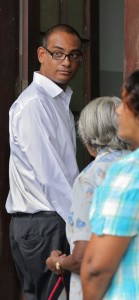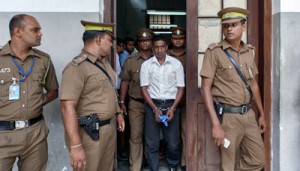News
Mel’s murder most foul solved, sealed and sentenced
View(s):A mix of good police work and a sharp prosecution strategy led to the successful conviction this week of the the murderer of journalist Mel Gunasekera.
Even though initially, the murder seemed an open and shut case, with the Police apprehending the suspect less than 48 hours after the brutal killing, the prosecution’s task of convincing the Bench that the suspect was indeed the murderer of Ms Gunasekera, meant recreating in the court house, in minute detail the events that unfolded, following the discovery of the victim’s body in her home at Battaramulla, in the early hours of February 2, 2014.

Mel Gnasekera
The prosecution led by Deputy Solicitor General (DSG) Shanil Kularatne relied on the CCTV camera footage from a neighbouring house, that showed the suspect in the vicinity of Ms Gunasekera’s residence on the morning of the murder, and followed it up with records of telephone calls and DNA tests on his clothing, to prove beyond reasonable doubt, that Arulanandu Ranson John alias “Paint Baas”, a handyman who had occasionally worked in the victim’s residence, had committed the heinous act.
During the trial, the Court was told that, soon after Police were informed of the murder by Ms Gunasekera’s family members, sniffer dogs were brought to the scene. A bloodied knife, a screwdriver and betel leaf stain were among the first leads the Police found at the crime scene. Using the scent on these, the sniffer dogs followed the steps of the suspect down the lane where the victim lived and passed a neighboring house which had a CCTV camera directed towards the road.
Even though the sniffer dogs scent ran dry, Police scrutinised the CCTV footage which showed the suspect near the door of the victim’s house, on the morning her body was found lying on the kitchen floor by her parents, on their return from church service, on that fateful Sunday morning. The CCTV footage showed him approaching the house twice and leaving once. The victim’s brother, when shown the footage, immediately identified the suspect as the paint bass who had worked in their house in December that year, and said he was a relative of a woman well known to their family. The CCTV footage also showed the suspect had changed his clothes when he left the house from, what he was seen wearing in the earlier footage. It was found those clothes belonged to the victims’ brother.

Mel's brother in court
Once the suspect’s identity was known, a Police team from the Special Crimes Investigation Unit at Mirihana was dispatched by its OIC Chief Inspector Nimal Karunaratne to Dompe, where the suspect lived. The suspect was not at home when the Police arrived, but they waited for him under the pretext of wanting to hire him for some work. “Paint Bass” arrived late in the night wearing the same clothes, and carrying a bag. Inside the bag were the clothes he had worn when he murdered Ms Gunasekera.
He had washed the clothes and packed them into the bag though the clothes were still wet. Ms Gunasekera’s blackberry phone too was in the bag. A police officer noticed some stains on the vest the suspect wore under his clothes and, suspecting it to be bloodstains, asked him to remove it and hand it over to the Police. As he was ordered to do so, the suspect had run to the back garden of the house where water from the kitchen was collected and fallen on it to hide the stains. By the time the Police reached the suspect and retrieved the vest, it was muddied, but DNA experts were able to trace bloodstains that matched those of the victim, and confirmed he was the assailant.
The suspect maintained throughout the trial that he did not commit the murder of Ms Gunasekera, but admitted he had approached her house on the day of the incident and rang the doorbell but, as there was no reply, he had gone away.
DSG Kularatne, in his closing remarks, said that a young promising life had been snatched away by the suspect who had entered the house to carry out a robbery, but left after murdering Ms Gunasekera. His brutal attack had left more than 50 injuries on her body. The murder had plunged her family into utmost grief, with her father, unable to bear the loss of his daughter, lying seriously ill in hospital.
The DSG appealed to the presiding judge to give the suspect the severest possible sentence, taking into consideration the heinous nature of his crime, so that it would serve as a deterrent to others from committing such crimes.
Colombo High Court Justice Piyasena Ranasinghe ruled that the prosecution had proved the suspect guilty of all charges beyond reasonable doubt and sentenced him to death for the murder of Ms Gunasekera. He was also found guilty of unauthorised entry into her residence and stealing her telephone, for which he was sentenced to 30 years rigorous imprisonment and imposed a fine of Rs 30,000.

The suspect being led away after the sentence was announced. Pix by Sameera Weerasekera

